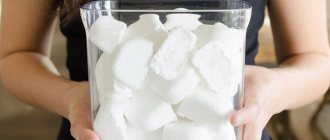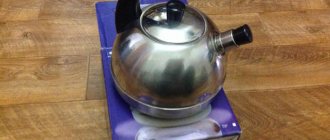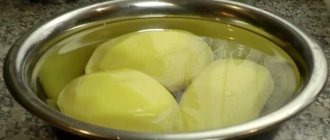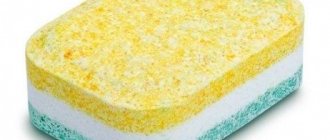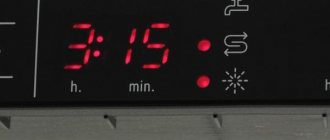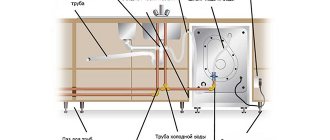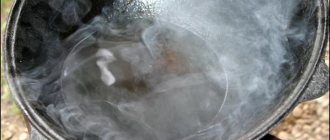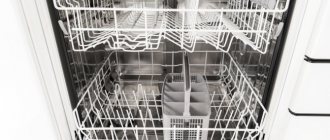In every family, purchasing new household appliances, such as a dishwasher, is an exciting event. The first start of the dishwasher (hereinafter also referred to as PMM), which was recently purchased in a store and managed to be connected to the electrical network, water supply and sewerage, is also important.
The first launch of new technology always causes excitement
What you need to know before running your dishwasher for the first time
The dishwasher (hereinafter also referred to as PMM, dishwasher) cannot be turned on for the first time after immediately filling it with dishes. First you should do a test run, and here's why:
- At the final stage of production, PMM is not cleaned of waste that accompanies each production process. In addition, there are traces left on it from the hands of production workers and store visitors inspecting the goods. Therefore, the first start of the dishwasher in test mode is necessary to clean the unit from grease, dirt, debris and fatty deposits.
- A test run will ensure that is working properly . Unfortunately, this cannot be done in the store. A test run will show whether the PMM was damaged during transportation to the owner’s kitchen.
- Another important reason for testing the PMM is to check that the dishwasher connected No one is immune from errors when installing communications. Drawing water, heating it and draining it during testing will show whether the machine is connected correctly.
- to understand how to control the operation of the dishwasher during the first idle start, in order to use the PMM correctly in the future.
To test and clean the PMM, you need to stock up on three components:
- detergent;
- dish rinse aid;
- salt specifically intended for PMM.
The special salt for dishwashers contains ingredients designed to soften tap water, prevent the appearance of scale on the electric heater (TEH), and also provide better dishwashing. There is a special reservoir for salt - an ion exchanger, into which it must be poured.
The detergent cleans surfaces of grease deposits. The rinse aid removes any remaining dirt. Household chemicals from the European brand Bon, intended for use in dishwashers, have proven themselves well.
In addition to the above household chemicals intended for the daily operation of PMMs, tablets, powders and other compositions are now produced that are intended for use during a test run of an automatic dishwasher. They contain all the necessary components.
Why can't you use regular table salt?
Many owners are tempted to use regular table salt because it is much cheaper than the kind designed to run dishwashers. Although their composition is 95% similar, there are still several significant differences:
- The degree of purification of table salt is much lower, although it is intended for cooking. In addition to the main element - sodium chloride - it contains such chemical elements as iron, manganese, potassium, iodine and others. They do not have the best effect on the operation of the PMM.
- Granules of specialized salt are much larger than table salt crystals. Therefore, detergent intended for dishwashers dissolves more slowly.
If you want your dishwasher to serve for a long time and trouble-free, use a special salt composition designed for its operation.
The video informs you about what household chemicals are best used in PMM:
Choice of product
Test activation requires the use of specialized household chemicals for PMM. It will allow you to clean the inside of the machine from dirt, adjust the product consumption manually during subsequent uses (in the case of inexpensive dishwashers without the function of recognizing and dispensing detergent) or program the chemical consumption.
There are several options for PMM products:
- combination tablets for dishwashers;
- specialized salt;
- dish rinse aid;
- powder/gel.
Salt for PMM is ordinary sodium chloride of high purity, has the form of large granules and is intended to soften water, prevent the appearance of scale on the heating element, and increase the efficiency of washing dishes. Despite the almost identical composition, such a product cannot be replaced with ordinary table salt when starting the dishwasher for the first time. First, beneficial contaminants in food-grade sodium chloride can have a detrimental effect on the operation of the machine. Secondly, the granules of specialized salt are much larger, which makes it more economical to use when using PMM.
Powder or gel is used to remove dirt, carbon deposits and grease from dishes. What to use is an entirely individual choice. The rinse aid allows you to completely remove food and detergent residues and adds additional shine and freshness.
Special powders are produced for the first start of the dishwasher. They contain concentrated active substances that can eliminate industrial dirt and grease, and the packaging itself is designed for one use.
“3 in 1” tablets are universal, suitable for both first start and everyday use, they contain all the necessary components. In this case, it is important to select the appropriate mode: the PMM menu will indicate which function supports their use.
Attention : specialized chemistry for a test run cannot be used for everyday purposes!
The need for a test run
For the first time, you should not immediately fill the dishwasher with dirty dishes. Before the first full cycle, a test run is carried out. It will help clean the dishwasher from foreign contaminants. After all, at the final stage of production, waste that appears during assembly remains on the device. Fingerprints of store visitors and sellers remain on the case. During the test run, all these traces will be washed away.
By turning this on, you can make sure that the dishwasher is working properly. In a store environment, conduct a full check of the dishwasher’s performance. After all, it can be damaged while the PMM is being transported from the store to the house.
Another important reason for conducting a test run is to check the correctness of the communication systems. Mistakes happen to everyone. Therefore, an extra check that the water is supplied correctly, heated and drained will show how the machine is connected. During the idle cycle, you can figure out how to operate the device and how to select the desired program.
Why do you need an idle start?
Some parts of the dishwasher may come with factory lubricant, and during the connection process small debris could get inside, which will subsequently clog the filters. Most contaminants can be removed with a damp cloth, but some will only be removed after an idle run. You also need to get acquainted with kitchen renovations: figure out how much and what products you need to use to get the best result. But all this is just the tip of the iceberg. The main thing is that the first launch will help check the correct installation and operation of household appliances.
At this stage, the main problems of the dishwasher (if any) may become apparent:
- Correct water supply and its complete removal after completion of the cycle;
- Serviceability of the heating element and correct temperature settings;
- Efficiency of the drying process.
Be sure to use salt and dishwasher detergent when you first start. Idle work does not negate the use of special chemicals.
Control panel and modes
The location of the dishwasher control panel depends on the type of device. For the built-in model, buttons and indicators are located at the end of the door. Freestanding machines have a panel on the front of the cabinet.
Expert opinion
I work in the household appliance repair industry. Extensive experience in restoring washing machines and dishwashers.
Ask a Question
In most cases, the user is able to understand the meaning of the symbols on the buttons intuitively. If a problem arises with this, you can always find clarification in the instructions.
Bosch offers customers a wide variety of models with various modes and great functionality. When choosing a program, you should focus on the number of dishes and the degree of soiling. As a rule, the machine is equipped with the following modes:
- standard;
- fast;
- delicate;
- intensive;
- economical.
The more intensive the cleaning, the greater the consumption of water and electricity. The use of multi-stage processing, including pre-soaking, washing, several rinses and drying, is justified only when the machine is fully loaded with very greasy dishes. The standard program is suitable for everyday use.
Delicate modes are included for items made of thin glass, or in the case of joint loading of dishes made of different materials.
The presence of several types of drying is of no small importance. PMMs in the mid-price segment are equipped with condensation drying, its action is based on creating a high temperature in the chamber. Expensive models are equipped with a powerful fan, which ensures quick drying of dishes without streaks.
BOSCH SD4P1B
Preparing for the first launch
Before turning on a dishwasher of any brand for the first time, empty it from its packaging and peel off all technological stickers. The compartment for loading salt is located at the bottom and is closed with a lid. Remove it and pour 1 liter of water inside. The amount of salt specified in the instructions for the device is also placed there. It ranges from 500 g to 1 kg. Sometimes after adding salt, some of the liquid leaks out. This is normal; the container will no longer require water during subsequent use.
Many PMMs are equipped with special strips for assessing water hardness. In accordance with them, the salt consumption for the device is programmed automatically or adjusted manually. To determine the amount of dissolved salt in water, special sensors are provided. When they show a value below the minimum level, the ion exchanger is replenished with a portion of salt.
The back of the door is equipped with several compartments into which tablets are placed, gel is poured, or powder is poured. If tablets are used to wash dishes, no additional products are needed, since they effectively combine detergent and rinse aid.
Detergent powder is loaded in a certain quantity. Not all PMM models are equipped with sensors responsible for the dosage of this product. Inexpensive dishwashers use up the entire volume of detergent loaded into it in one use. Therefore, powder is poured into them in the amount prescribed by the instructions.
The same rule applies to rinse aid. In expensive modern models it can be filled with a reserve. Simpler ones require portioned pouring of rinsing gel.
What happens when you start the dishwasher for the first time?
Even if you are filled with impatience, do not rush to turn on the PMM. Read the instructions carefully. The first run is a test run, so there is no need to load dishes. This condition applies to dishwashers of all popular brands - Bosch, Siemens, Electrolux, Samsung, Miele and others. If you purchased a built-in model, install it in a furniture niche only after the first installation has been successfully completed.
Checking all connections before using the dishwasher for the first time
Before turning on the dishwasher for the first time, it must be connected to the utilities. When you turn it on for the first time, it will become clear whether the work on installing the PMM was carried out correctly, and whether this household device is ready for long-term use.
Below are the main reasons why dishes are not washed when you first turn them on:
- During the production process and further sale, dust, dirt, stains and grease deposits accumulate inside the PMM from the hands of workers, sellers and buyers. All this is removed during the first launch.
- All systems are tested for serviceability. You can determine how quickly the water flows and heats up, how the modes for draining used liquid and drying dishes work, and whether the chamber has been cleaned well.
- All connections to the water supply and sewerage systems are checked for leaks. The dishwasher should not be pushed into a furniture opening before first use, so that there is access to possible leakage areas. The correct installation of the electrical network is also checked.
- Owners receive knowledge on how to operate a dishwasher. This will help them use this equipment correctly, avoiding mistakes in further operation.
If a leak is immediately detected when you turn it on for the first time, it must be eliminated.
Procedure before first start
any packaging materials or advertising stickers left in the chamber , which can be found in Bosch dishwashers of the SPV series, Hansa and many other models of popular brands.
Pay attention to the foam packaging balls , of which there are quite a lot inside the PMM. All this must be removed when detected.
Also wipe the camera with a clean cloth to remove any obvious signs of dirt .
Mechanical cleaning of the dishwasher chamber before first use
Although dishes are not loaded into the PMM, the corresponding compartments still need to be filled with special softening salt, washing powder or gel, rinse aid , or use a 3-in-1 tablet that combines detergent and rinse aid.
First dishwashing
If the test is successful, the dishwasher is installed in the opening prepared for it. If the dishwasher is disconnected from the power supply, it will have to be set up again when it is reconnected - do not forget about this .
Salt, rinse aids and washing powders from the Finish brand are relatively inexpensive and popular among PMM users
Then you can perform the first full cycle with loading dirty dishes. For the first wash, you need to load detergents intended not for the first start, but for washing bowls, plates and other utensils. The most economical detergent compositions are those produced in powder form.
Utensils must be loaded strictly in accordance with the rules established by the manufacturer
Pay special attention to the rules for loading dishes into the PMM. The quality of cleaning utensils from grease and dirt depends on this process. To avoid mistakes, carefully read the instructions supplied with the machine again. The main condition is to place the dishes in such a way that they are completely washed by the liquid from the sprinklers .
Be careful: if you open the dishwasher door immediately after the program has finished, you may get scalded by the steam.
Selecting the desired program
After loading detergents and kitchen utensils, another important stage begins - choosing the appropriate program for the operation of the PMM. All modes are divided into several groups, the names of which may differ among different manufacturers.
Main programs:
- Washing with pre-soaking – the program is designed for equipment with burnt or dried food residues and a large amount of fatty deposits. The work is carried out in two stages - preliminary and main washing.
- Intensive wash – designed for very dirty dishes. The effect is achieved due to the high temperature of the water. This mode cannot be used for dishes made of plastic or with delicate coatings.
- Standard mode - allows you to wash dishes with a moderate degree of soiling at a moderate water temperature.
- Economical program - used for washing relatively clean tableware, while the consumption of energy, water and detergent is minimal.
- Delicate sink – designed for plastic, porcelain and crystal dishes, as well as devices with delicate coatings.
- Quick wash - used to easily rinse plates, forks and spoons with detergent.
Common dishwashing programs
Proper operation of the dishwasher guarantees its long-term operation without breakdowns. We hope that our article will help you understand the nuances of turning on the device for the first time.
How to turn on the dishwasher
After loading all detergents and rinsing agents, turn on the device for the first time. Before doing this, check once again that the machine is strictly horizontal in level. Then check how well the water supply and waste solution drain hoses are connected. They also check the electrical connection.
After all checks, perform the following steps sequentially:
- Open the shut-off valve to supply water.
- Open the door of the device and check how freely the sprayer moves. To do this, scroll it by hand.
- Unscrew the drain filter and rinse it under the tap. To more effectively get rid of industrial contaminants and dust, additional detergents are used. The washed filter is installed in its original place.
- On the dashboard you select which detergent will be used.
- Set the desired mode. For the first test run, select the longest program. The heating of water is also made the greatest.
- Close the dishwasher door and start the device.
While the machine is operating in test mode, the following indicators are monitored:
- During normal operation, the water supply occurs without interruption. The dishwasher does not stop working.
- The water is heated by the heating element to the desired temperature. This parameter cannot be checked in the store. Therefore, it is important to ensure that the water is heating up during the idle start-up process.
- The drainage is carried out completely, the water does not linger.
- After the cycle is completed, there is no water left inside the device.
Important!
If the test run does not reveal any malfunctions, the device is left to dry and cool for several hours. Only then do they load the dishes into it and start using it.
Sequence of actions when turning on for the first time
Once all the ingredients are loaded, you can run the dishwasher for the first time. Actions are performed in the following sequence:
- Check again whether the household appliance is installed strictly horizontally.
- Check the reliability of the connections of the supply and drain hoses, as well as the connection to the electrical network.
- Open the shut-off valve that closes the flow of water in emergency situations.
- Open the PMM door and make sure that the sprayer rotates freely around its axis (turn it by hand).
- Unscrew the drain filter and then rinse it under running water. For better cleaning from industrial dirt and dust, use cleaning products. Return the filter device to its seat.
- Select the type of detergent to be used on the panel (tablet or powder, salt and rinse aid).
- Set the desired mode - during a test run it should be as long as possible. The water temperature should also be as high as possible.
- Close the PMM door and start the washing process.
Many models of Bosch dishwashers are equipped with a special tablet for trial use.
Dishwasher operation and care
After successful completion of the test cycle, begin daily use of the dishwasher. For long and uninterrupted service of the appliance, select a high-quality detergent, correctly load dishes and kitchen utensils into baskets, and select the desired program.
Selection of detergents and rinses
To ensure that your dishes are always clean, choose high-quality detergents suitable for the specific brand of device. In this case, washing powders are not used. Before purchasing, evaluate the following parameters:
- The release form can be powder, gel or tablet. They have different laundering quality and cost-effectiveness.
- The composition of chemical preparations with a complex effect includes several active substances. Each ingredient does a specific job. Therefore, you need to choose a product depending on the degree of contamination and the type of dishes.
- Some drugs contain aggressive components. Therefore, they choose only safe products that do not harm sick people, children or pets.
In addition to preparations for washing dishes, for effective operation of the device you will need preparations that soften tap water, products for cleaning the dishwasher chamber and removing scale from heating elements.
Before purchasing detergents, take into account their composition. To wash stubborn dirt and remove difficult stains, preparations containing chlorine are suitable. They do an excellent job of removing any stains and adding whiteness. Such compositions are suitable for washing dishes with a durable coating. But such products are not used for cutlery made of silver, cupronickel, crystal or porcelain.
Important!
Do not use detergents with aggressive ingredients for hand-painted dishes. The drawing may suffer from their influence.
A successful replacement for a chlorine-containing product would be products with enzymes. They are substances with a slightly alkaline reaction that carefully wash away all contaminants. They do not harm delicate surfaces and perform well in cold water. Their only drawback is the lack of whitening effect.
Review of manufacturer's models
The devices have several series, which differ in size, capacity, and cost. Below are rating models that gained their popularity thanks to user ratings.
Built-in standard
Full-sized built-in dishwashers from Electrolux have an average width of 60 cm. They are distinguished by their large capacity and the presence of various modes.
Electrolux ESL 9531 LO
The full-size dishwasher is designed for 13 sets, while consuming up to 10 liters of water. The device is equipped with leakage protection, a clean water sensor, and condensation drying. The machine is controlled using 5 programs and 4 temperature modes.
- there is a child lock;
- good capacity;
- there is a connection to hot water;
- low noise level.
- no water hardness adjustment;
- takes a long time to wash.
Electrolux ESL 7310RA
The built-in full-size PMM measuring 59*55*81 cm, despite its compactness, has a large loading chamber. It is designed for 13 sets of dishes. The adjustable basket allows you to load even large pots or large diameter plates. Using the digital display, you can set the desired program, and there are only 6 of them.
Recommendations
In the future, the dishwasher will be operated taking into account the recommendations specified in the instructions for use. As you use it, add rinse aid and detergent to the machine. It is advisable to use a new portion of the product each time, rather than leaving residue from the previous wash in the appliance.
Be sure to control the amount of salt in the ion exchanger. All dishes are arranged according to the rules, avoiding overload. This significantly reduces the quality of washing. The sprayer and nozzles are periodically checked for cleanliness and the filters are not clogged. Operating modes are selected depending on the stage of contamination.
Important!
To extend the life of the device when connecting it to the network, do not use extension cords or adapters. Do not touch the device with dirty hands. Keep children away from the dishwasher while it is running. It is important to ensure that no foreign objects get inside the PMM. Periodically clean the internal surfaces of the dishwasher and filters from dirt and grease accumulations.
Rules for using PMM
Any instructions for Electrolux, Bosch, Coopersberg machines indicate safety precautions. By following them, you will extend the life of your equipment:
- Do not touch the PMM body with wet hands after switching on.
- Do not connect equipment via an extension cord.
- Clean the drain filter after the wash cycle.
- Clean your car with special products every six months.
If you follow our recommendations, starting the dishwasher for the first time will not bring any difficulties. A video on the topic will help you do everything right:
